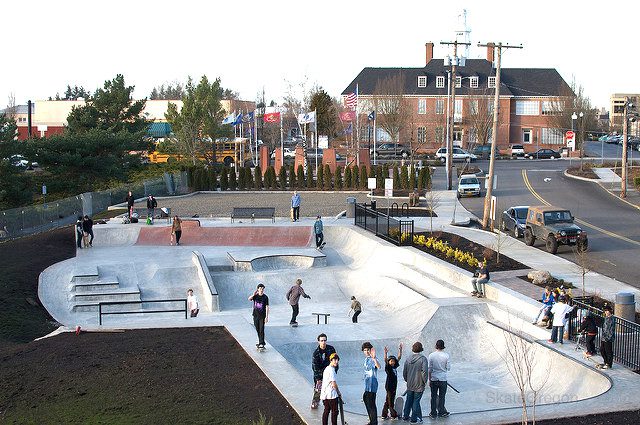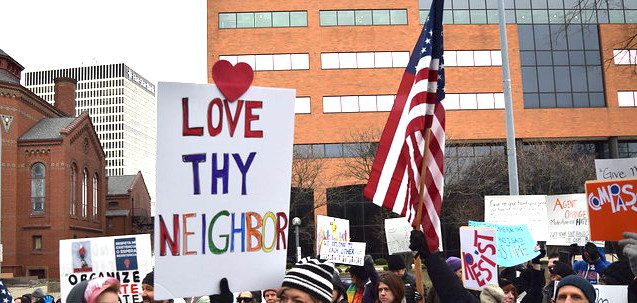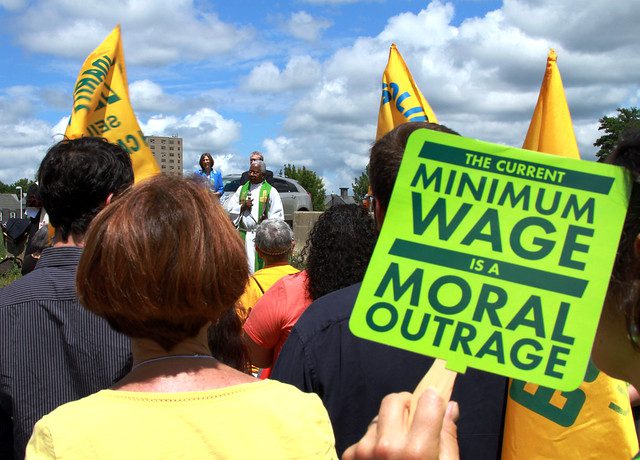
SkatePark in Main City Park by Skate Oregon via flickr, CC BY 2.0.
“We need to stop letting capital set the urban terms. Cities need to plan their own megaprojects, invest in the transportation network, make those parks, and then let the developers in to fill them out—on the city’s terms.” —Alexandra Lange, “At Hudson Yards, The Future Isn’t Now,” Curbed, March 15
We tend to ignore unscientific city ranking lists (9 most dangerous cities! Top 17 cities to raise a small dog!) because they tend to be extremely subjective, and full of hidden biases. But we were definitely intrigued by the note in Livability.com’s methodology about their 100 Best Places to Live this year, that based on a survey showing affordability is Millennials’ top concern (apparently the rest of us don’t even merit surveying?), they instituted a home value cap: “This year, no city on the Top 100 Best Places to Live list has a median home value above $250,000.” It’s just another sign of the times—like the Boston University study that found that affordable housing is also the top concern of mayors of cities 75,000 and over, and a major reason they believe people are moving away from their cities.
Where’s the safety net? A growing number of older homeless people—about 44 percent (!!)—first began living on the streets after they were 50, according to an ongoing study. And another recently released study projects that the elderly homeless population will nearly triple in the next decade. It’s an extremely upsetting situation that is getting worse, but can we really be shocked? We can’t say it better than Margot Kushel, the UCSF professor who heads the ongoing study, explained: “This is what happens when you pay people a minimum wage they can’t live on and is worth less than it used to be, there is way too little affordable housing, and there are practically no pensions anymore. They were never able to build wealth, save for their old age. You put all these together, and we are ‘shocked, shocked, shocked’ that homelessness among older people is rising?”
Ending Chronic Homelessness: A partnership between Kaiser Permanente and Community Solutions aims to end chronic homelessness in 15 communities by utilizing data and analytics that focuses on the social determinants of health. “We know there is no simple solution to such a complex problem, but through strategic partnerships, such as the one with Community Solutions, we believe it can be solved,” says Kaiser’s Chief Community Health Officer, Dr. Bechara Choucair.
Detroit’s tree-planting program foundered, not because its residents don’t like trees, but because they don’t trust the city, and no one consulted them in the program’s design, an environmental justice researcher found. Wow, it’s like people don’t like being told what they want or that something is for their own good. Who’da thunk.
Greg Casar, a city council member in Austin, Texas, says you can be pro-housing [construction] and anti-gentrification, in a op-ed explaining his vote against rezoning a particular affordable housing development despite his general support for increased construction, supply, and density. We imagine rapidly appreciating areas like Austin would benefit from more people thinking like Casar, rather than drawing all-or-nothing battle lines.
SB50, this year’s version of California state Sen. Weiner’s statewide upzoning bill, contains more protections for areas at risk of gentrification. While it seems too early to say whether those added protections are sufficient, there’s one very intriguing addition. In addition to upzoning around transit stops, the bill now also requires upzoning in “job rich” areas. This is very promising, as it gets around the problem of adding transit in areas that want to stay low density, but also want to host large companies. Adding housing in those areas could further all the stated goals of the bill—shrink commutes, provide more access to jobs, and reduce pressure on housing costs. We suspect, though the numbers aren’t in, the inclusion of this provision will do a better job of actually getting wealthier areas to pull their fair share in housing provision. Cue a ton of haggling over what a “job rich” area is in 3, 2, 1…
Meanwhile, statewide tenant protection, which many housing advocates see as a necessary prerequisite to equitable upzoning, is also on the agenda in California, in a package of bills being called the “Keep Families Home” bill package, covering just cause eviction, rent control, and rent gouging.
A number of old buildings located in historically Black neighborhoods in Portland are at risk of collapse in earthquake conditions. The city council passed an ordinance requiring that owners of unreinforced masonry buildings—which includes homes, historic churches, and businesses—prominently post a sign that explains this safety issue. But the community isn’t happy about the ordinance, saying the signs will lead to loss of property value and displacement. “The impediment will act as a nonnegotiable contract to devalue property, force disinvestment, and coerce dispossession under the guise of public safety for the benefit of speculative redevelopment,” says the Portland branch of the NAACP.
Striking a Deal: Oakland, Calif., teachers ended a seven-day strike after the school district approved a new contract that included an 11 percent raise over four years and other concessions. The affordability crisis in the Bay Area had fueled the strike, as school personnel have found it increasingly difficult to live in the city where they work. “Teaching in the Bay Area used to be a profession for which home ownership was attainable,” said Janelle T. Scott, an associate professor of education at UC Berkeley. “Younger teachers don’t even see that as a possibility.”





Comments